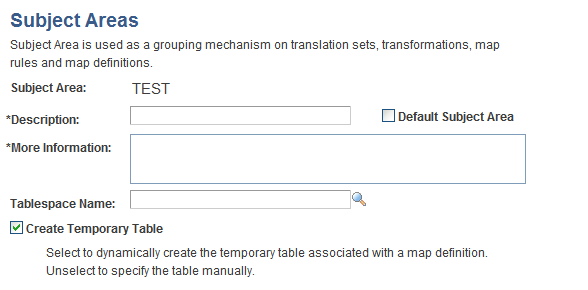Defining Subject Areas
This section provides an overview of subject areas and discusses how to define subject areas.
|
Page Name |
Definition Name |
Usage |
|---|---|---|
|
EOEW_OBJ_OWNER |
Define subject areas to group translation sets, transformations, map rules, and map definitions. |
Use subject areas as a grouping mechanism on translation sets, transformations, map rules and map definitions. These objects can only be shared within a subject area. An enterprise subject area can be used for objects that are to be shared by all subject areas.
You need to carefully plan subject areas when you implement PeopleSoft Data Transformer. For example, you need to consider how the Data Transformer objects (translation sets, transformations, map rules, map definitions, and so on) can be grouped most efficiently. Some objects need to be available to all users, while some only to a specific user or functional group.
Note: Subject areas affect only prompting and object selection and do not reflect object security.
You can set up default tablespaces, or you can dynamically create temporary tables by subject area. If an implementation requires that only groups of maps dynamically generate temporary tables, or are built within different tablespaces, you can specify this at the subject area level.
Use the Subject Areas page (EOEW_OBJ_OWNER) to define subject areas to group translation sets, transformations, map rules, and map definitions.
Navigation:
This example illustrates the fields and controls on the Subject Areas page. You can find definitions for the fields and controls later on this page.

Field or Control |
Description |
|---|---|
Default Subject Area |
Select to use this subject area as your default subject area. Note: Only one subject area can be selected as the default, which becomes available to all users—it is your enterprise subject area. |
Tablespace Name |
Select the tablespace name to use if you want to override the Data Transformation installation options selection for this subject area. Note: This is needed only when an implementation shares dynamically generated temporary tables over multiple tablespaces. For example, the CEW EO temporary tables may be assigned to a special tablespace because the table size in this area is expected to be larger than other tables. For that subject area, an override tablespace name would be entered. The CEW CM subject area contains unique tables that also need special segmentation. For that subject area, an override tablespace name would be entered. All other subject areas would have a blank tablespace name therefore defaulting to the Data Transformation installation options tablespace name. |
Create Temporary Table |
Select if you want to override the Data Transformation installation options selection for this subject area. This is needed only when an implementation allows or disallows the dynamic temporary table creation per subject area. |